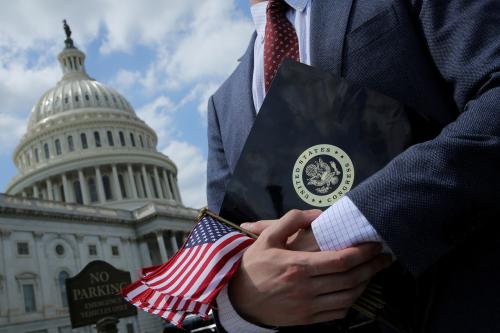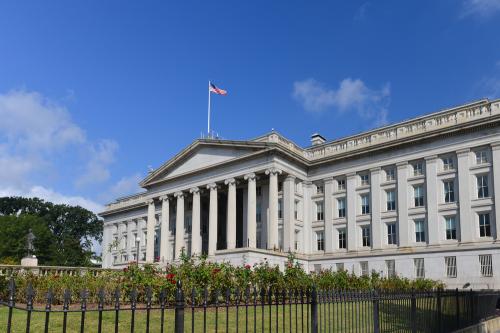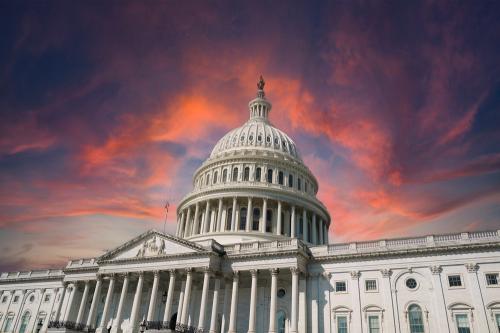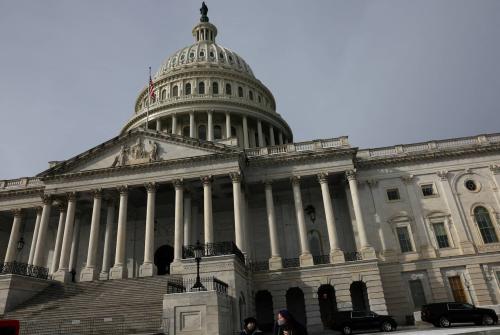Once again, some lawmakers in Congress are proposing the creation of a fiscal commission—a body other than the standing committees of Congress—to recommend changes to federal spending and taxes in order to restrain the growth in the federal debt. This explainer looks at the history of fiscal commissions and current proposals to form another one.
Why do some lawmakers think we need a fiscal commission now?
The federal debt is now close to 100% of GDP. This is close to the peak reached after World War II. The Congressional Budget Office projects that—without changes to tax and spending laws—the debt will rise to 115% of GDP by 2033 and 181% of GDP by 2053. What’s more, the Medicare trust fund will be depleted in 2031 and the Social Security trust fund in 2034, according to the latest official projections. But Congress has, so far, been unwilling to tackle these long-term challenges. As a result, some members of Congress think a commission is needed to propose ways to do so.
In a November House Budget Committee hearing, Rep. Scott Peters (D-CA) said a commission could prevent a fiscal crisis from being resolved by a “last-minute, backdoor, 11th hour deal between party leaders.” Not all members of Congress, however, agree. At another meeting of the House Budget Committee, Ranking Member Brendan Boyle (D-PA) said that he’s “more than a little bit skeptical that a commission would work, just frankly given the past history of the last dozen years.”
What are examples of successful commissions, those that have led to policy changes?
Congress has created commissions with a variety of mandates and compositions over the past few decades. The table at the end of this post, adapted from a 2018 essay by our Brookings colleagues Stuart M. Butler and Timothy Higashi, lists prominent commissions and their outcomes.
The 1981 National Commission on Social Security Reform, often called the Greenspan Commission after its chairman Alan Greenspan, is often cited as a success. In the early 1980s, the Social Security trust fund was months away from insolvency that threatened the ability of the government to pay full benefits. President Ronald Reagan created the panel with an executive order and tasked it with devising measures to restore financial stability to the Social Security system. The commission had 17 members, 7 of whom were lawmakers. After the commission initially failed to reach an agreement, a smaller group of commissioners began assembling in closed-door meetings, often involving high-ranking White House officials. The details of these internal debates are not widely known, but the commission eventually made recommendations that became the foundation for the 1983 Social Security reforms. These reforms delayed cost-of-living adjustments, began taxing the Social Security benefits going to high earners, and accelerated the implementation of an already-legislated increase in payroll taxes. The Greenspan Commission was successful, in part, because the problem was imminent, and its importance was widely understood. In addition, the compromise it recommended was backed by the White House and Congressional leaders, including, importantly, House Speaker Tip O’Neill.
In the late 1980s, after a long period of gridlock and bitter debate over military expenditures, Congress and the White House created the Defense Base Realignment and Closure Commission (BRAC), tasked with selecting which military bases would be shut. The commission assembled between 7 and 12 independent experts in different rounds, many including retired military officials, former members of Congress, and business leaders. None were elected officials. BRAC made five rounds of recommendations, closing more than 350 military bases and resulting in about $12 billion in savings each year until 2013.
BRAC gave political cover to the administration and members of Congress on which bases to close because they could say that outside experts had made the choices. The President and Congress had authority to accept or reject the proposals, but not to alter the list. Also, lawmakers agreed on the aims of the commission. As the Cold War drew to a close and the budget situation worsened, Congress understood that shutting down costly military bases was necessary to reduce growing annual deficits.
What are examples of unsuccessful commissions?
In 2010, after several failed attempts to fashion a plan to address the nation’s worsening fiscal outlook, President Barack Obama established by executive order the National Commission on Fiscal Responsibility and Reform, known informally as the Simpson-Bowles Commission for its co-chairs, Republican Alan Simpson and Democrat Erskine Bowles.
The 18 members included 12 members of Congress (both Democrats and Republicans) and six others. The commission was tasked with developing recommendations to address the nation’s budget imbalance. The final Simpson-Bowles proposal included tax increases, reductions in healthcare spending, Social Security reforms, and discretionary spending cuts, which in aggregate was projected to have stabilized the debt at 60% of GDP by 2023. (The projections were made before COVID-related spending and tax cuts increased the debt.) The President’s executive order required that the proposal be approved by 14 of the 18 members before advancing to Congress. The plan fell short by three votes. For that reason, the commission is widely regarded as a failure, although components of its recommendations were later enacted. Weak support from leadership posed a problem for Simpson-Bowles. Commission member Paul Ryan, who served as House Budget Committee Chairman at the time, voted against the proposal. The Obama White House, in the end, didn’t provide enthusiastic support for the Simpson-Bowles plan.
Less than a year following the Simpson-Bowles Commission failure, Congress established the Joint Select Committee on Deficit Reduction, often referred to as the “Super Committee,” to gain congressional approval for raising the federal debt ceiling. The Committee was comprised entirely of lawmakers—six from each party selected by congressional leadership. It was charged with identifying $1.5 trillion in savings over the next decade. Everything was up for discussion, including cuts to mandatory spending like Social Security and Medicare.
The bill that created the commission included a “trigger” that would automatically initiate $1.2 trillion dollars in spending cuts should Congress or the Super Committee fail to reach a deficit reduction compromise. After several months of debate, the Super Committee announced that it was unable to reach a bipartisan agreement. The budget sequestration was activated, leading to spending cuts totaling $109 billion each year until 2023, most of which came from defense and other discretionary programs.
Two main reasons are cited for the committee’s failure. First, there were large divisions between the parties: Democrats insisted that any cuts to major benefit programs be accompanied by tax hikes, but Republicans would not agree to higher taxes. Second, neither Congressional leaders nor President Obama offered strong support.
What are the broad lessons of why some commissions work, and others fail?
Congress establishes commissions when lawmakers are looking for a way to distance themselves from policy changes that are likely to be unpopular. In short, they are a way for Congress to delegate the decision-making process to avoid blame. But the hurdles to success for a commission are high because they are generally created to wrestle with politically unpopular issues.
In order for a commission to produce changes in policy, history suggests, Congress first needs to agree on a clearly defined problem. As Butler and Higashi put it, “There needs to be broad public and political agreement on the reason for a commission and its goals.”
In addition, successful changes in policy recommended by a commission ultimately need backing from the White House and Congressional leaders.
According to veterans of the congressional budget process, a strong endorsement from the President is particularly important for a commission aimed at stabilizing the national debt. Long-time director of the Senate Budget Committee G. William Hoagland, now at the Bipartisan Policy Center, has said: “The first lesson from the history of fiscal commissions is the unquestionable prerequisite that the president, regardless of party, be directly involved in making the case to the public, interest groups, and the business community that fiscal responsibility is real and necessary.”
What are the recent proposals for a fiscal commission?
The Fiscal Commission Act, introduced by Reps. Bill Huizenga (R-MI) and Scott Peters (D-CA) would create a 16-member commission tasked with recommending ways to improve the long-run fiscal outlook by stabilizing the debt-to-GDP ratio at or below 100% within 10 years. It would be instructed to identify ways to reduce spending, increase revenues, and ensure that the Medicare and Social Security trust funds are solvent for a minimum of 75 years.
The commission would be comprised of six senators (three Democrats and three Republicans), six members of the House (three Democrats and three Republicans) and four private sector experts. The majority and minority leaders of the Senate and House would each choose one of those experts.
The commission would be instructed to submit a policy recommendation in the fall of 2024. The plan would need approval of a simple majority of commission members before it could advance to Congress.
The bill requires that both chambers of Congress vote the recommendation up or down without any amendments.
The bill was advanced by the House Budget Committee in January 2024 by a vote of 22-12, with three Democrats joining all the committee’s Republicans.
A similar bill has been introduced in the Senate by senators Joe Manchin (D-WV) and Mitt Romney (R-UT). Their bill would allow only the 12 commissioners who are members of Congress to vote on recommendations.
Reps. Ed Case (D-HI) and Steve Womack (R-AR) have introduced the Sustainable Budget Act every Congress since 2019. The act would establish an 18-member National Commission on Fiscal Responsibility and Reform “to improve the fiscal situation in the medium term and to achieve fiscal sustainability over the long term” by proposing ways to balance the federal budget—excluding interest payments—over the next 10 years.
The president would appoint six members (no more than four from the same political party), and the leadership of Congress would appoint six senators (three Democrats and three Republicans) and six members of the House (three Democrats and three Republicans).
The bill stipulates that a proposal must receive support from 12 of the 18 commissioners before advancing to the President, and it gives the President a more substantial role than the Fiscal Commission Act does. The President would then have 60 days to send Congress a proposal based on the commission plan—explaining any changes that he is recommending. That proposal would get expedited consideration in Congress without amendment.
The history of commissions
The table below, adapted from the 2018 essay by our Brookings colleagues Stuart M. Butler and Timothy Higashi, lists prominent commissions and their outcomes.
-
Acknowledgements and disclosures
The Brookings Institution is financed through the support of a diverse array of foundations, corporations, governments, individuals, as well as an endowment. A list of donors can be found in our annual reports published online here. The findings, interpretations, and conclusions in this report are solely those of its author(s) and are not influenced by any donation.







Commentary
When and why does Congress create fiscal commissions?
January 19, 2024